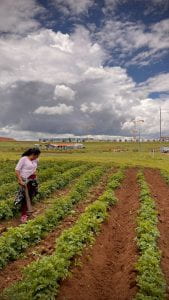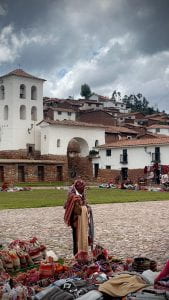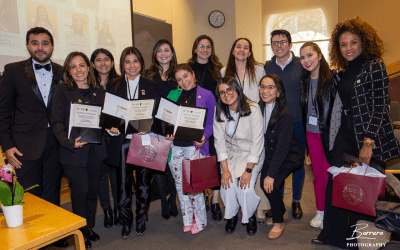
About the Author
Rodrigo Miguel Martel Orihuela is pursuing a Master of Architecture in Urban Design MAUD ‘24 at the Harvard Graduate School of Design. He graduated with honors with a bachelor’s degree in architecture in 2017 from Ricardo Palma University in Lima, Peru. He is passionate about the trans-disciplinary outlook of housing and urban studies and design, public policies, urban governance, heritage conservation, and citizen participation.
Acerca del Autor
Rodrigo Miguel Martel Orihuela está cursando una Maestría en Arquitectura en Diseño Urbano MAUD ’24 en la Escuela de Graduados de Diseño de Harvard. Se graduó con honores con una licenciatura en arquitectura en 2017 de la Universidad Ricardo Palma en Lima, Perú. Es apasionado por la perspectiva transdisciplinaria de los estudios y diseño de vivienda y urbanismo, políticas públicas, gobernanza urbana, conservación del patrimonio y participación ciudadana.
Andean Cultural Landscapes in Danger
The Chinchero International Airport
Cusco stands as one of the most culturally and ecologically captivating regions globally. Once the capital of the Incan empire and presently recognized as Peru’s primary tourism hub, its extensive archaeological and natural resources have elevated it to a preeminent position among global tourist destinations. Despite experiencing significant demographic and urban transformations with the rise of tourism as a cornerstone of its economy, the region exemplifies a unique sense of vernacular cosmopolitanism seldom encountered elsewhere in Peru. My passion for architectural and urban conservation has led me to develop a special relationship with this fascinating region motivating me to develop my urban design thesis research and proposal in Cusco. With the support of the David Rockefeller Center for Latin American Studies (DRCLAS) I got the chance to travel during January 2024 and explore firsthand the region’s cultural and natural beauty.
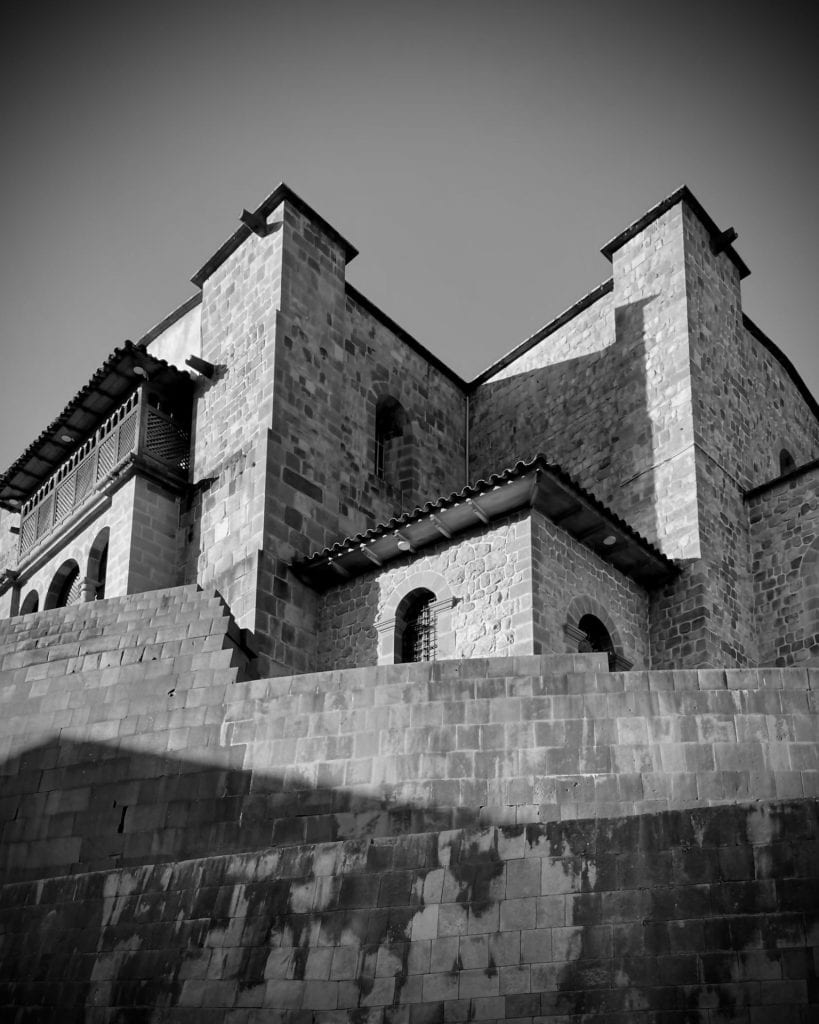
Qorikancha Temple in Cusco city. Photograph taken by author.
Cusco, proclaimed a World Heritage Site by UNESCO in 1983, offers a special testimony to the Incan civilization, representing the culmination of more than three millenniums of a complex layered and autonomous cultural development. However, it also carries the heavy burden of its colonial and republican pasts charged by racial and social exclusion which is manifested in its urban design and architecture.
The rich and complex process of cultural hybridization which gave birth to the immense cultural heritage and the contemporary urban identity has its roots in violent superimposition of religious and cultural processes. Most of the Spanish colonial settlements were deliberately built over Incan structures, physicalizing political power and socio-racial structures through the application of the Indies law (legal systems and codes established during the Spanish colonial period in Peru which influenced governance, land ownership, and social structures). Its domestic and public architecture are products of that syncretism that can be found across the Cusco region. Many other localities in the region possess hierarchical racial orders embedded in its urban design, like Chinchero, a city on the edge of experiencing radical urban and development changes, and that I got to visit as part of the research proposal.
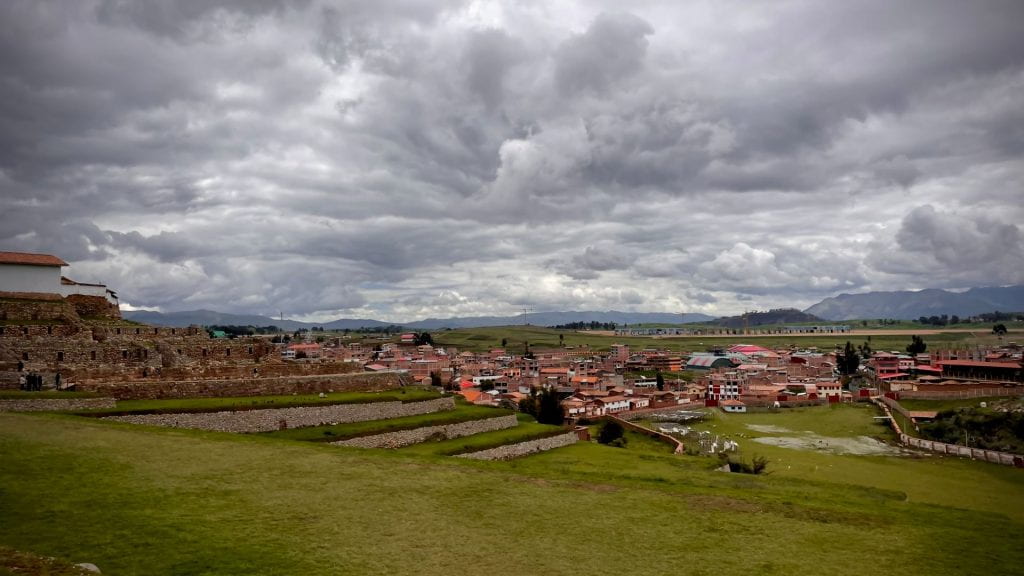
View of the city of Chinchero and the new International Aiport. Photograph taken by the author.
Chinchero is a small urban conglomerate strategically situated on the Chinchero Plateau, a flat area within the Andean mountain chain 22 miles away from Cusco City to which I travelled through an informal van that departs as soon as it gets full. Positioned along a section of a national road that connects the urban settlements in the Cusco Region, it has geographic importance because of its proximity to Cusco and the Sacred Valley of the Incas, more specifically, Ollantaytambo, an Incan sacred and agricultural site serving as the departure point for the journey to Machu Picchu by train. As soon as I got there I could perceive the contemporary identity of the town of Chinchero marked by a layered history that, in chronological order, dates to pre-Incan settlements followed by its posterior Incan occupation constituted by what is now the Chinchero Archaeological Park.
The site was a royal palace built amid a landscape surrounded by impressive natural beauty with significant hydrological resources like the lagoons of Piuray and Huaypo, overseeing the distant snowy mountains of Salcantay, La Verónica, and Soraq. The palace was built for recreational and meditational purposes, with special considerations on its stone material and its urban and architectural quality as it was a space destined for the elite. During my visit to the archaeological complex, I experienced firsthand the majestic agricultural terracing system that seamlessly merges human intervention with the surrounding landscape.
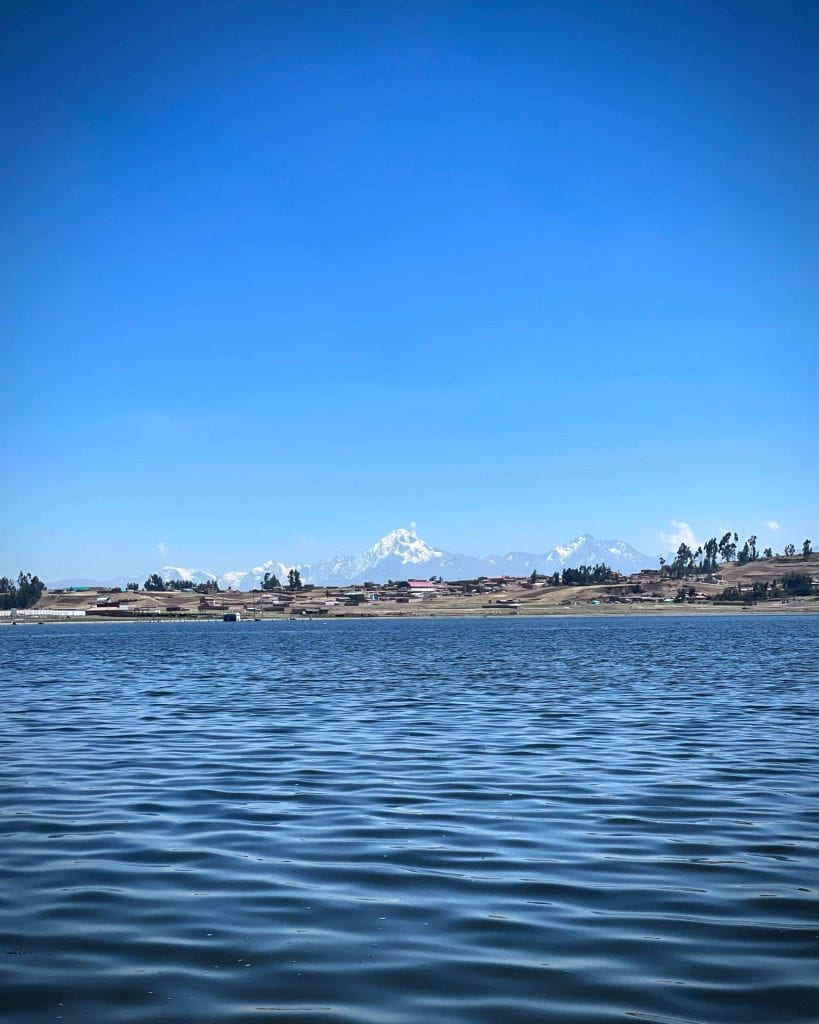
Piuray Lagoon. Photograph taken by the author.
The posterior occupation of Chinchero during the colonial period is marked by the characteristic violent superimposition justified with evangelization. The colonial urban settlement placed on top of the Incan structures, now recognized as the historic center of Chinchero, dates to 1603 and consists of a mixture of both adaptations and reoccupations, focused chiefly on sacred structures. The first urban expansion of the core occurred in the first half of the 20th century, and the more contemporary urban occupation of the last three decades correlates with the neoliberal urbanization logics of illegal and informal occupation that have defined the 21st-century urban Peruvian landscapes.

View of the city of Chinchero and the new International Aiport. Photograph taken by the author.
Unregulated urbanization processes already compromise the delicate balance of Chinchero’s patrimonial heritage and sociocultural fabric. While contemporary challenges facing the region may not be explicitly racialized as in colonial and early republican times, the relentless pursuit of development and welfare in a rapidly urbanizing area has led to a significant imbalance in conserving its cultural landscapes. Controversial decisions made by the central government exacerbate this situation, as they will significantly influence the region’s future development, thereby having a profound and negative impact on its intangible heritage and social fabric.
The pre-Hispanic and colonial legacies are the cornerstone of Peru’s tourism industry, and the necessity for a better equilibrium between developmentalism and conservation hinders its potential. According to the Chamber of Commerce, Services, Industry, Tourism, and Production of Cusco, tourism constitutes a vital subsistence economy in Cusco, representing more than 14% of its Gross domestic Product (GDP) and the influx of tourists has exponentially grown by 176% from 2007 to 2017 after Machu Picchu was declared one of the New Seven Wonders of the World. This economy has produced a phenomenon that academics define as “touristification.” As a direct consequence, this industry has driven and determined the contemporary urban growth of the Cusco region. The capacities of the current Alejandro Velazco Astete International Airport in the city of Cusco have been heavily surpassed in the last decades, and the urban fabric has completely encroached upon the physical infrastructure. This infrastructural gap has prevented the tourism industry and related services from growing at a higher rate.
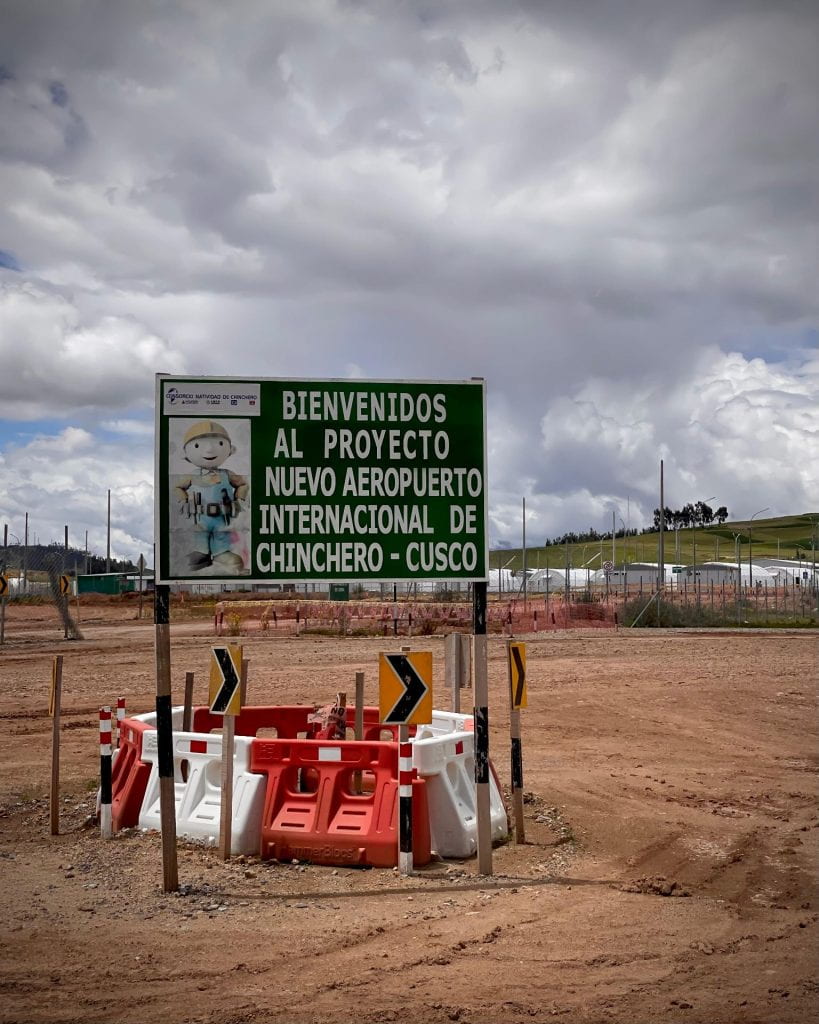
Welcome sign for the construction site of the new International Airport. Photograph taken by the author.
To spur economic growth in the region and mitigate the heavily centralized nature of the country, where Lima exerts significant dominance over other urban centers, the government proposed a series of infrastructure projects at the turn of the 21st century. This attempt, lacking comprehensive planning and leveraging populist sentiment against Lima prevalent in other provinces of Peru, aimed to decentralize power and invigorate local economies and industries.
Due to the increasing global pressure of tourism, the significant operational shortcomings, and the challenging urban conditions of the current airport in Cusco city, Chinchero was formally designated in October 2001 as the location for constructing a larger international airport particularly because of its geographic conditions atop a plateau. This project was declared a national imperative and the foremost priority for the Peruvian state. The envisioned new aerial infrastructure seeks to capitalize on Chinchero’ s geographic advantages at a regional scale due to its proximity to Cusco and Ollantaytambo, and rank as the second largest airport in the country. By 2028, it aims to surpass four million travelers a year, establishing direct connections between the region and major metropolises across the Americas, breaking down the longstanding centralist relationship with Lima.
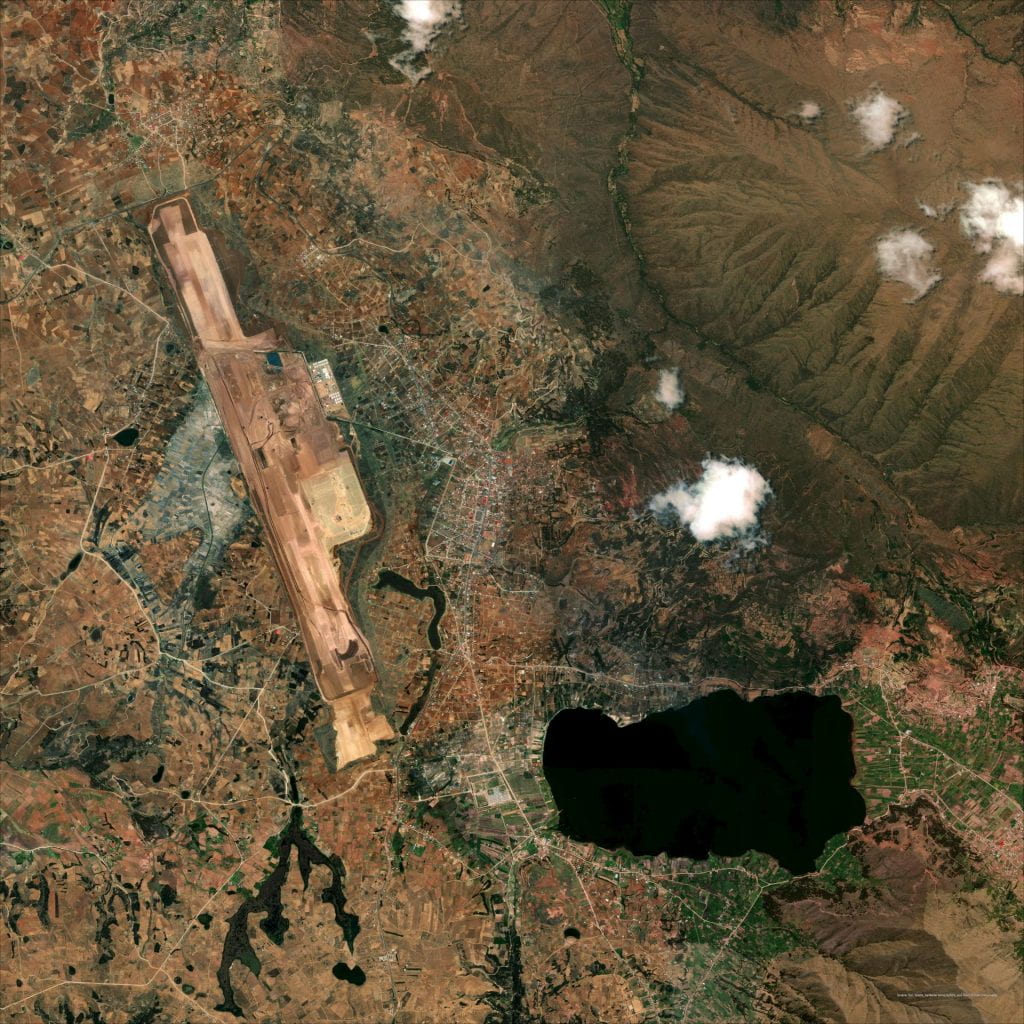
Image 6: Satellite image of the new Chinchero International Airport Source: ArcGIS.
The almost 5500 inhabitants of this town, who mostly economically rely on subsistence agriculture and world class textile production, belong to one of the most ancestral political organization systems in the rural Peruvian ambit known as “comunidades campesinas” or peasant communities. These constitute a direct inheritance from Incan practices known as Ayllus that rely heavily on communal social structures. This communal aspect provides families with conditions and opportunities for production while also regulating the boundaries of family production.
- Locals in Chinchero. Photograph taken by the author.
- Locals in Chinchero. Photograph taken by the author.
This dynamic relationship is seen as integral to the production methods within peasant families, with the community serving as a socio-economic entity blending individual and collective elements. The Peruvian state has created a legal and juridical framework in the General Law of Peasant Communities that preserves communal land ownership and water management systems integrated by a set of family units. Even though the tourism industry has created overall urban growth and an alternate source of income, it is essential to question the government’s decision to place this mega infrastructure in such a fragile context. Since its conception, the project has been criticized because of its location and proximity to urban and rural settlements directly fragmented and destroying the communal land ownerships systems of the peasant communities of Yanacona, Ayllo Racchi and Ayllopongo.
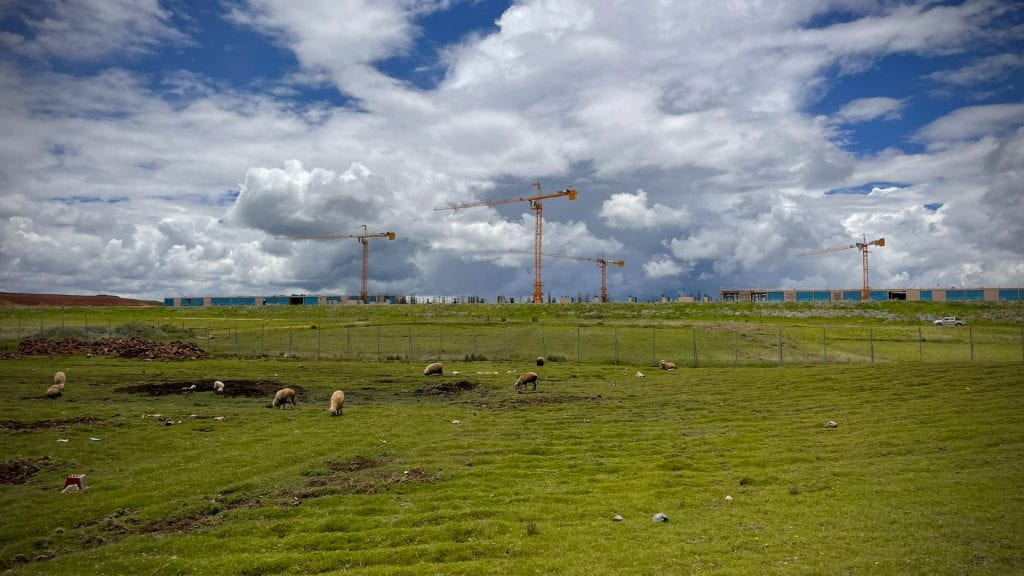
Construction of the new International Airport. Photograph taken by the author.
The winter research grant allowed me to discover firsthand the deep-layered urban history of Chinchero and engage in meaningful conversations with public servants at the local level of government who will be in charge of developing the urban development plan after the construction of the airport, which has already become a political tool causing spatial and social segregation. However, by visiting the site, I had the opportunity to engage in vital informal conversations with the residents and understand their varied views about the significance of the project, which, even though it is already causing significant sociocultural and ecological imbalances, is seen as a beacon of hope that will bring “development” and economic growth to the region.
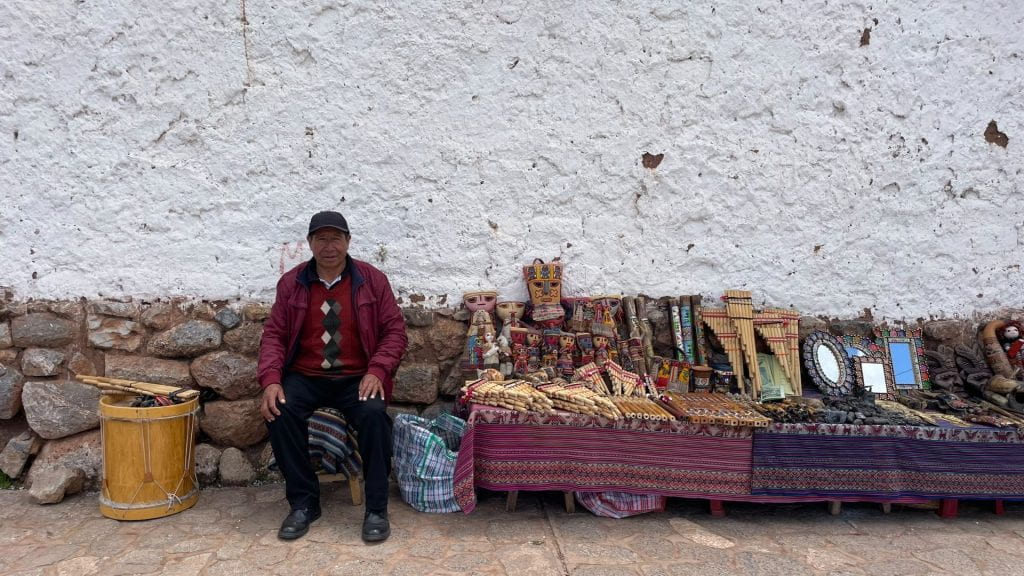
Jesus Quillahuamán at the Chincehro Archaeological Park. Photograph taken by the author.
Cusco se erige como una de las regiones más cautivadoras cultural y ecológicamente a nivel mundial. Una vez capital del imperio incaico y hoy reconocida como el principal centro turístico de Perú, sus extensos recursos arqueológicos y naturales la han elevado a una posición importante entre los destinos turísticos globales. A pesar de experimentar significativas transformaciones demográficas y urbanas con el auge del turismo como piedra angular de su economía, la región ejemplifica un sentido único de cosmopolitismo vernáculo raramente encontrado en otro lugar de Perú. Mi pasión por la conservación urbana y arquitectónica me ha llevado a desarrollar una relación especial con esta fascinante región, motivándome a realizar mi investigación y propuesta de tesis en diseño urbano en Cusco. Con el apoyo del Centro David Rockefeller para Estudios Latinoamericanos (DRCLAS), tuve la oportunidad de viajar en enero de 2024 y explorar de primera mano la belleza cultural y natural de la región.

Qorikancha Temple in Cusco city. Photograph taken by author.
Cusco, proclamada Patrimonio de la Humanidad por la UNESCO en 1983, ofrece un testimonio especial de la civilización incaica, representando la culminación de más de tres milenios de un desarrollo cultural complejo, estratificado y autónomo. Sin embargo, también carga el peso de sus pasados colonial y republicanos marcados por exclusión racial y social, que se manifiesta en su diseño urbano y arquitectónico. El rico y complejo proceso de hibridación cultural que dio origen al inmenso patrimonio cultural y a la identidad urbana contemporánea tiene sus raíces en la superposición violenta de procesos religiosos y culturales. La mayoría de los asentamientos coloniales españoles fueron construidos deliberadamente sobre estructuras incas, materializando el poder político y las estructuras socio-raciales a través de la aplicación de la Ley de Indias (sistemas legales y códigos establecidos durante el período colonial español en Perú que influenciaron la gobernanza, la propiedad de la tierra y las estructuras sociales). Su arquitectura doméstica y pública son productos de ese sincretismo que se puede encontrar en toda la región de Cusco. Muchas otras localidades en la región poseen órdenes raciales jerárquicos incrustados en su diseño urbano, como Chinchero, una ciudad al borde de experimentar cambios urbanos radicales, y que tuve la oportunidad de visitar como parte de la propuesta de investigación.

View of the city of Chinchero and the new International Aiport. Photograph taken by the author.
Chinchero es un pequeño conglomerado urbano estratégicamente situado en la Meseta de Chinchero, una zona plana dentro de la cadena montañosa de los Andes a 22 millas de la Ciudad de Cusco, a la cual viajé en una van informal que parte tan pronto como se llena. Posicionado a lo largo de una sección de una carretera nacional que conecta los asentamientos urbanos en la Región de Cusco, tiene importancia geográfica debido a su proximidad a Cusco y al Valle Sagrado de los Incas, más específicamente, a Ollantaytambo, un sitio sagrado y agrícola incaico que sirve como punto de partida para el viaje a Machu Picchu en tren. Tan pronto como llegué, pude percibir la identidad contemporánea de la ciudad de Chinchero marcada por una historia estratificada que, en orden cronológico, se remonta a asentamientos preincaicos seguidos por su ocupación incaica posterior constituida por lo que ahora es el Parque Arqueológico de Chinchero.
El sitio fue un palacio real construido en medio de un paisaje rodeado de una impresionante belleza natural con importantes recursos hidrológicos como las lagunas de Piuray y Huaypo, con vistas a las distantes montañas nevadas de Salcantay, La Verónica y Soraq. El palacio fue construido con fines recreativos y meditativos, con consideraciones especiales sobre su material pétreo y su calidad urbana y arquitectónica ya que era un espacio destinado a la élite. Durante mi visita al complejo arqueológico, experimenté de primera mano el majestuoso sistema de terrazas agrícolas que se fusiona perfectamente con el paisaje circundante.

Piuray Lagoon. Photograph taken by the author.
La ocupación posterior de Chinchero durante el período colonial está marcada por la característica superposición violenta justificada con la evangelización. El asentamiento urbano colonial colocado sobre las estructuras incas, ahora reconocido como el centro histórico de Chinchero, data de 1603 y consiste en una mezcla de adaptaciones y reocupaciones, centradas principalmente en estructuras sagradas. La primera expansión urbana del núcleo ocurrió en la primera mitad del siglo XX, y la ocupación urbana más contemporánea de las últimas tres décadas se correlaciona con las lógicas de urbanización neoliberal de ocupación ilegal e informal que han definido los paisajes urbanos peruanos del siglo XXI.

View of the city of Chinchero and the new International Aiport. Photograph taken by the author.
Los procesos de urbanización no regulados ya comprometen el delicado equilibrio del patrimonio patrimonial y el tejido sociocultural de Chinchero. Si bien los desafíos contemporáneos que enfrenta la región pueden no estar explícitamente racializados como en los tiempos coloniales y republicanos tempranos, la búsqueda implacable de desarrollo y bienestar en un área rápidamente urbanizada ha llevado a un desequilibrio significativo en la conservación de sus paisajes culturales. Las decisiones controvertidas tomadas por el gobierno central agravan esta situación, ya que influirán significativamente en el futuro desarrollo de la región, teniendo así un impacto profundo y negativo en su patrimonio intangible y tejido social.
Los legados prehispánicos y coloniales son la piedra angular de la industria turística de Perú, y la necesidad de un mejor equilibrio entre el desarrollismo y la conservación obstaculiza su potencial. Según la Cámara de Comercio, Servicios, Industria, Turismo y Producción de Cusco, el turismo constituye una economía vital de subsistencia en Cusco, representando más del 14% de su Producto Interno Bruto (PIB) y el flujo de turistas ha crecido exponencialmente en un 176% desde 2007 hasta 2017 después de que Machu Picchu fuera declarado una de las Nuevas Siete Maravillas del Mundo. Esta economía ha producido un fenómeno que los académicos definen como “turistificación”. Como consecuencia directa, esta economía ha impulsado y determinado el crecimiento urbano contemporáneo de la región de Cusco. Las capacidades del actual Aeropuerto Internacional Alejandro Velazco Astete en la ciudad de Cusco se han visto ampliamente superadas en las últimas décadas, y el tejido urbano ha invadido completamente la infraestructura física. Esta brecha de infraestructura ha impedido que la industria turística y los servicios relacionados crezcan a un ritmo más alto.

Welcome sign for the construction site of the new International Airport. Photograph taken by the author.
Para impulsar el crecimiento económico en la región y mitigar la naturaleza altamente centralizada del país, donde Lima ejerce un dominio significativo sobre otros centros urbanos, el gobierno propuso una serie de proyectos de infraestructura a principios del siglo XXI. Este intento, que carecía de una planificación integral y aprovechaba el sentimiento populista contra Lima predominante en otras provincias de Perú, tenía como objetivo descentralizar el poder y revitalizar las economías e industrias locales.
Debido a la creciente presión global del turismo, las importantes deficiencias operativas y las difíciles condiciones urbanas del aeropuerto actual en la ciudad de Cusco, Chinchero fue designado formalmente en octubre de 2001 como la ubicación para construir un aeropuerto internacional más grande, especialmente debido a sus condiciones geográficas en lo alto de una meseta. Este proyecto fue declarado una imperativa nacional y la prioridad principal para el estado peruano. La infraestructura aérea nueva prevista busca capitalizar las ventajas geográficas de Chinchero a escala regional debido a su proximidad a Cusco y Ollantaytambo, y clasificarse como el segundo aeropuerto más grande del país. Para 2028, tiene como objetivo superar los cuatro millones de viajeros al año, estableciendo conexiones directas entre la región y las principales metrópolis de las Américas, rompiendo la relación centralista de larga data con Lima.

Image 6: Satellite image of the new Chinchero International Airport Source: ArcGIS.
Los casi 5500 habitantes de este pueblo, que dependen principalmente económicamente de la agricultura de subsistencia y la producción textil de clase mundial, pertenecen a uno de los sistemas de organización política más ancestrales en el ámbito rural peruano conocidos como “comunidades campesinas”. Estas constituyen una herencia directa de las prácticas incas conocidas como Ayllus que dependen en gran medida de las estructuras sociales comunales. Este aspecto comunal brinda a las familias condiciones y oportunidades para la producción, al tiempo que regula los límites de la producción familiar.
- Locals in Chinchero. Photograph taken by the author.
- Locals in Chinchero. Photograph taken by the author.
Esta relación dinámica se considera integral para los métodos de producción dentro de las familias campesinas, con la comunidad sirviendo como una entidad socioeconómica que combina elementos individuales y colectivos. El estado peruano ha creado un marco legal y jurídico en la Ley General de Comunidades Campesinas que preserva la propiedad comunal de la tierra y los sistemas de gestión del agua integrados por un conjunto de unidades familiares. Aunque la industria turística ha generado un crecimiento urbano general y una fuente de ingresos alternativa, es esencial cuestionar la decisión del gobierno de ubicar esta mega infraestructura en un contexto tan frágil. Desde su concepción, el proyecto ha sido criticado por su ubicación y proximidad a asentamientos urbanos y rurales directamente fragmentados y destruyendo los sistemas de propiedad comunal de las comunidades campesinas de Yanacona, Ayllo Racchi y Ayllopongo.

Construction of the new International Airport. Photograph taken by the author.
La beca de investigación de Invierno me permitió descubrir de primera mano la historia urbana profundamente estratificada de Chinchero y participar en conversaciones significativas con funcionarios públicos a nivel local del gobierno que estarán a cargo de desarrollar el plan de desarrollo urbano después de la construcción del aeropuerto, que ya se ha convertido en una herramienta política causando segregación espacial y social. Sin embargo, al visitar el sitio, tuve la oportunidad de participar en conversaciones informales vitales con los residentes y comprender sus variadas opiniones sobre la importancia del proyecto, que, aunque ya está causando importantes desequilibrios socioculturales y ecológicos, se ve como un faro de esperanza que traerá “desarrollo” y crecimiento económico a la región.

Jesus Quillahuamán at the Chincehro Archaeological Park. Photograph taken by the author.
More Student Views
Colombian Women Who Empower Dreams
English + Español
The verraquera of Colombian women knows no bounds. This was the message left with me by the March 30 symposium, “Empowering Dreams: 1st symposium in honor to Colombian women at Harvard.”
A Review of Born in Blood and Fire
The fourth edition of Born in Blood and Fire is a concise yet comprehensive account of the intriguing history of Latin America and will be followed this year by a fifth edition.
Resilience of the Human Spirit: Seizing Every Moment
In the heart of Chicago, where I grew up, amidst the towering shadows of adversity, the lingering shadows of generational demons and the aroma of temptation, the key to the gateway of resilience and determination was inherited. The streets of my childhood neighborhood became, for many, prisons of poverty, plundering, crime and poor opportunity.

